#houghton library
Explore tagged Tumblr posts
Text

The Four Avenging Angels, colored woodcut by Albrecht Dürer from the book Apocalipsis cu[m] figuris, printed in Nuremberg in 1498. Now in the Houghton Library, Harvard University.
#art#art history#Albrecht Dürer#religious art#Biblical art#Christian art#Christianity#apocalypse#Book of Revelation#Northern Renaissance#German Renaissance#engraving#woodcut#German art#15th century art#Houghton Library
87 notes
·
View notes
Text

Emily Dickinson, It struck me – every Day –, Poems: Packet V, Mixed Fascicles. Includes 15 poems, written in ink, dated ca. 1862 [((22c)). Emily Dickinson Archive. Houghton Library, Harvard University, Cambridge, MA. CC BY-NC-ND 3.0]
Bibl.: The Complete Poems of Emily Dickinson, Edited by Thomas H. Johnson, Little, Brown and Company, Boston, MA, and Toronto, 1960, pp. 171-172
It struck me – every Day – (J362, Fr636) It struck me – every Day – The Lightning was as new As if the Cloud that instant slit And let the Fire through – It burned Me – in the Night – It Blistered to My Dream – It sickened fresh upon my sight – With every Morn that came – I thought that Storm – was brief – The Maddest – quickest by – But Nature lost the Date of This – And left it in the Sky –
#manuscript#handwriting#calligraphy#poetry#book#emily dickinson#thomas h. johnson#little brown and company#houghton library#1860s#1960s
31 notes
·
View notes
Text
Léon Bakst
1866–1924
Costume design for a nymph in The Afternoon of a Faun (L’Après-midi d’un Faune), 1912
Watercolor, pencil, and gold paint on paper
Harvard Theatre Collection, Houghton Library, Howard D. Rothschild Collection; pfMS Thr 41.4 (5)

#léon bakst#1866–1924#Costume design for a nymph in The Afternoon of a Faun#L’Après-midi d’un Faune#1912#Watercolor#pencil#and gold#paint on paper#Harvard Theatre Collection#Houghton Library#Howard D. Rothschild Collection#pfMS Thr 41.4 (5)#artist painter#original art#art#art work#art style#ilustration painter#art colors#naturalist painter#watercolor colors#oil on panel#woodblock print#woman’s art#frank murdoff#ooctoopussy#xpuigc#xpuigc bloc
13 notes
·
View notes
Text
The procession of the months: the verses by
Beatrice Crane
the designs by
Walter Crane
1889
Houghton Library, Harvard University,

#Beatrice Crane#verses.#walter crane#designs#ilustration#artwork#Houghton Library#art style#harvard university#mael omer#illustration#xpuigc#xpuigc bloc
6 notes
·
View notes
Text
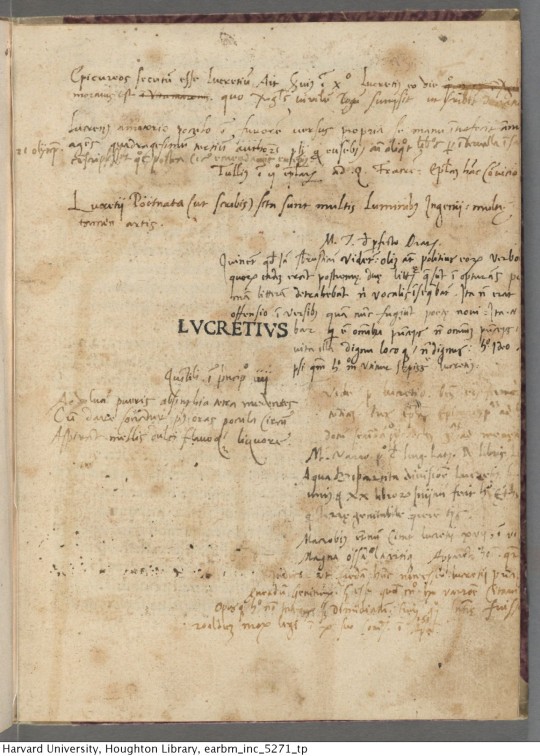
Rob Roy MacGregor notas a Lucrecio
2 notes
·
View notes
Text
Content Warning: The Smithsonian Magazine article contains minor details regarding the deceased individual's skin that may distress certain readers. I have tried to avoid anything I deemed unnecessary in the extracts I have chosen to replicate.
Note: I'll definitely need to revisit this when I have more time to investigate the details. I can't find an English translation of the book in question. I'm curious, though, as Harvard Library describes it as 'a meditation on the soul and life after death'.
anthropodermic bibliopegy - the practice of creating book bindings from human skin.
Note: The article briefly explains some background information on this practice. I have not copied any of that for this blog post, so if you are curious then be sure to click the link for the full write-up.
Author: Sarah Kuta Publication: Smithsonian Magazine Timestamp: April 16, 2024
Extract:
Des Destinées de L’Âme, or Destinies of the Soul [was] written by French author Arsène Houssaye in 1879. [A Harvard alum] John B. Stetson Jr. lent it to the university in 1934, and [...] his widow officially donated it in 1954.
[The book's] original owner was Ludovic Bouland, a French physician who received the book directly from the author. Bouland bound the book with human skin taken, without consent, from the body of a woman who died at a French psychiatric hospital where he worked, according to [Harvard University].
[...]
Harvard—and many other institutions, including the Smithsonian—have been reviewing their collections amid a growing outcry about their possession and treatment of human remains.
[...]
“The core problem with the volume’s creation was a doctor who didn’t see a whole person in front of him and carried out an odious act of removing a piece of skin from a deceased patient, almost certainly without consent, and used it in a book binding that has been handled by many for more than a century,” says [Tom] Hyry [Associate University Librarian for Archives and Special Collections].
/end of extract
Extract from Harvard Library's statement (bold in the second paragraph is from the original text):
The removal of the human skin from Des destinées de l’âme follows a review by Houghton Library of the book’s stewardship, prompted by the recommendations of the Report of the Harvard University Steering Committee on Human Remains in University Museum Collections issued in fall 2022.
[...]
[...] In 2014, following the scientific analysis that confirmed the book to be bound in human skin, the library published posts on the Houghton blog that utilized a sensationalistic, morbid, and humorous tone that fueled similar international media coverage.
Harvard Library acknowledges past failures in its stewardship of the book that further objectified and compromised the dignity of the human being whose remains were used for its binding. We apologize to those adversely affected by these actions.
/end of extract
Extracts from Harvard Library's 'Ask a Librarian' entry regarding Des destinées de l’âme:
A handwritten note by Bouland inserted into the volume states that “a book about the human soul deserved to have a human covering.”
[...]
A memo accompanying the book written by John Stetson, which has since been lost, [the] skin [belonged to] an unknown deceased woman patient from a French psychiatric hospital.
[...]
The human remains will be given a respectful disposition that seeks to restore dignity to the woman whose skin was used. The Library is now in the process of conducting additional biographical and provenance research into the anonymous female patient, the book, and Bouland, as well as consulting with proper authorities in France and at the University to help determine how best to carry this out. We expect this process to take months, and perhaps longer, to come to completion.
/end of extract

Harvard Library

Ludovic Bouland - Carlos Garcia Pozo, El Mundo

Arsène Houssaye - Getty Images

John B. Stetson Jr. - Wikidpedia
#anthropodermic bibliopegy#ethics#human skin#Harvard#Harvard Library#Houghton Library#Smithsonian#to investigate later#Report of the Harvard University Steering Committee on Human Remains in University Museum Collections#human remains#museum ethics#library ethics#stewardship practices#ethical standards#official statement#academic discourse#Arsène Houssaye#Des destinées de l'âme#desecration#human dignity#late 19th century#Des Destinées de L’Âme#Destinies of the Soul#historical malpractice#archives and special collections#medical history
0 notes
Note
You recently reblogged something about anatomical collections, which made me curious: what are some of the grossest or most interesting grotesque things in your collection? I've handled Victorian hair books which was interesting, but I'm always looking for more curiosities!
An excellent question! I wouldn't say we have anything particularly gross or grotesque in the collection in terms of physical composition, unless you consider vellum and parchment to be gross.
The book I was referring to is Saggi di Anatomia Pittorica, a late 18th century anatomical reference guide, and it might be my favorite part of the collection just for how uniquely interesting it is. It's bound in a fairly unassuming leather cover, but it contains some incredible anatomical references. What makes the manuscript and the anatomical drawings in particular so curious is the posing.
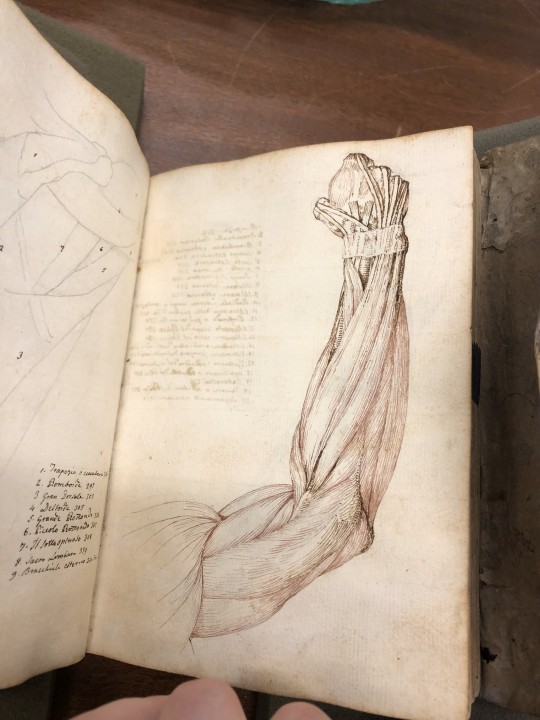
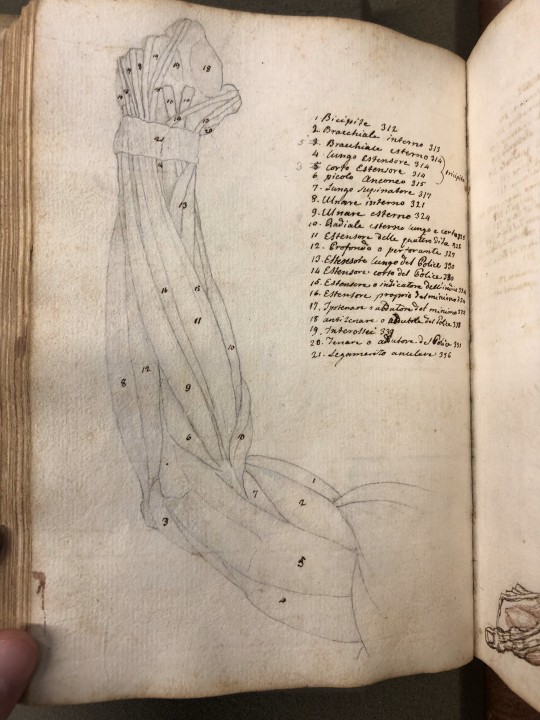
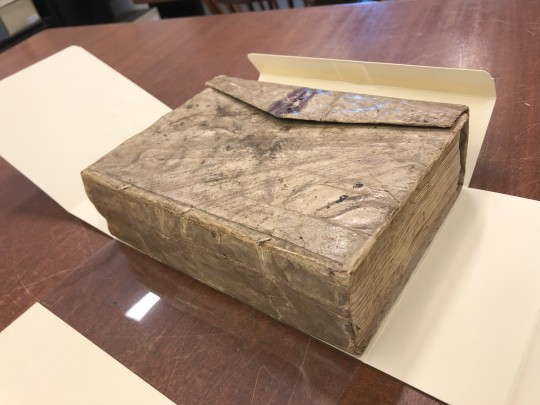
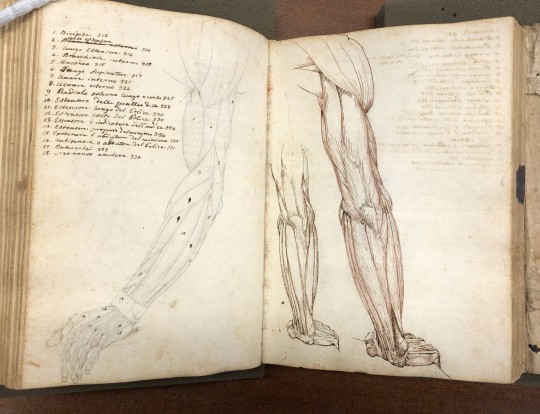
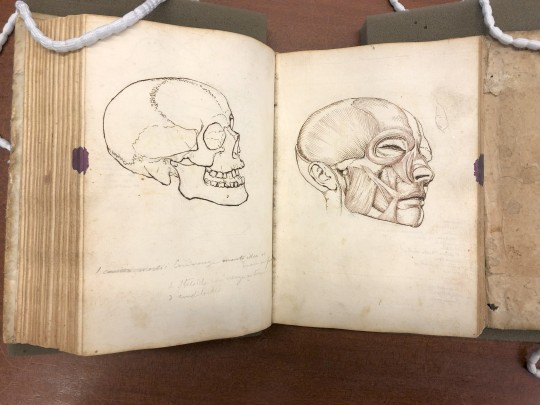
The manuscript seems to have been designed specifically as an anatomical reference book for artists, only depicting the parts of human anatomy most relevant to artists and posing the limbs, head, and torso dynamically for better reference—legs and ankles are drawn in various states of flexion, arms lean on tables, and heads roll back on exposed necks. Each drawing is labeled on the back of the page, perhaps allowing artists to consistently identify and draw different muscle groups and bones.
Saggi di Anatomia Pittorica or "Anatomy" is a part of our special collections and can be found on Hollis.
Hollis ID: 99156425481603941
#harvardfineartslibrary#fineartslibrary#harvardlibrary#specialcollections#manuscript#anatomical illustration#tw anatomy#anatomy#human anatomy#library#anatomy reference#art reference#thank you for the ask!#this is genuinely one of my favorite parts of the collection both as an artist and library worker#I've never personally handled victorian hairbooks but would be curious to see some#those would be more in Houghton's wheelhouse than ours though#asks#asks open
20 notes
·
View notes
Text
youtube
2 notes
·
View notes
Text
Harvard Removes Book Binding Made From Dead Woman's Skin From Library! The Skin-bound Version of "Des destinées de l’âme" Was at Harvard Since 1934.
For nearly a century, a library at Harvard University had a book bound by human skin — until a recent decision to remove it. Arsène Houssaye's "Des destinées de l'âme" was published in 1879, however, the volume in question was bound in a Woman's Skin by French physician Dr. Ludovic Bouland and has been in the university's collection since 1934, according to a Harvard announcement. Bouland bound the book with skin he took "Without Consent" from the body of an unnamed deceased female patient from a French Psychiatric Hospital where he worked.
— ByLeah Sarnoff | March 28, 2024
For nearly a century, the Hallowed Halls of Harvard University's Houghton Library had a book bound by Human Skin among the of 20 Million Books — until a recent decision to remove it.
Arsène Houssaye’s "Des destinées de l’âme" was published in 1879, however, the volume in question was bound in Human Skin by French physician Dr. Ludovic Bouland and has been in the University's Collection since 1934, according to Harvard's announcement Wednesday.
The book's premise is a reflection on the soul and life after death, and a handwritten note by Bouland inserted into the volume states that "a book about the human soul deserved to have a human covering," according to the University.

Arsène Houssaye’s "Des destinées de l’âme" was published in 1879 and was bound in human skin by Dr. Ludovic Bouland. Harvard University
Dr. Bouland bound the book with skin he took "without consent" from the body of an unnamed deceased female patient from a French psychiatric hospital where he worked, the announcement said.
The removal of the human skin from the book follows a review by Houghton Library, prompted by the recommendations of the Fall 2022 report from the Harvard University Steering Committee on Human Remains in University Museum Collections.
However, Paul Needham, a prominent scholar of early modern books and Harvard alumni, told ABC News the decision follows a consistent, 10-year call to remove the binding and an open letter he co-authored that was published as an advertisement in The Harvard Crimson this month.
"I first raised the question with the library almost 10 years ago, in June 2014. And I requested they should have the human skin respectfully removed and given a decent burial," Needham said. "I think that the open letter is what finally moved them really to take action and make a statement because until yesterday we have not gotten the university to say a single word about binding in almost 10 years."
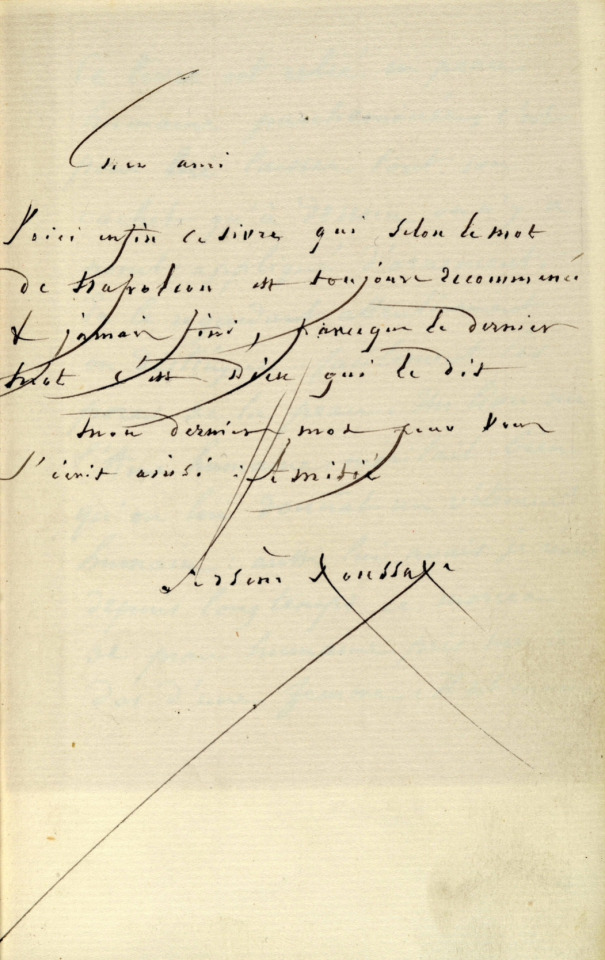
Arsène Houssaye’s "Des destinées de l’âme" was published in 1879 and was bound in human skin by Dr. Ludovic Bouland. Harvard University
"I'm very glad that they finally have made a statement," Needham added. "It is absolutely the right thing to do."
Harvard University declined to comment on Needham's open letter to ABC News.
In 2014, the University publicly confirmed that the binding was made from human skin, however, the 19th-century book remained available to "anyone who asked for it," Harvard said in the statement, "regardless of their reason for wishing to consult it."
A Harvard library associate revealed that "decades ago" the book was used to "haze" Houghton Library student employees by asking them to "retrieve the book without being told it included human remains," according to Harvard's press release.
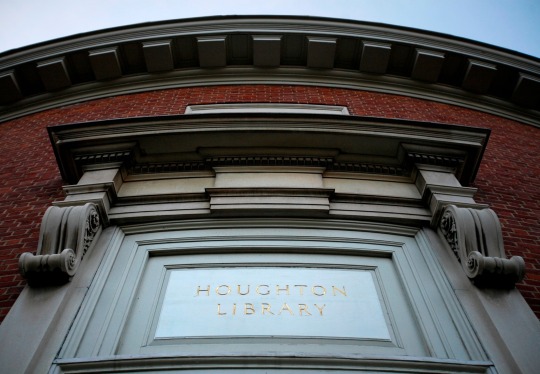
In this Feb. 20, 2008, file photo, the Houghton Library is shown on the campus of Harvard University in Cambridge, Massachusetts. The Boston Globe via Getty Images
Tom Hyry, Harvard's associate university librarian for archives and Anne-Marie Eze, associate librarian of Houghton Library conducted a Q&A on Wednesday where they explained why the book remained in the collection for nearly a century.
"We’ve been working towards this for a few years now as part of the University’s larger project of addressing human remains in its collections," Eze, who chaired a Houghton Library task force researching the practice of binding books in human skin, said. "The review confirmed that we can have reasonable certainty that Bouland removed and utilized the skin without consent."
Addressing the "past failures in our stewardship of the book," Hyry apologized and maintained that the University is "determined to move forward with care."
"We apologize on behalf of Harvard Library for past failures in our stewardship of the book that further objectified and compromised the dignity of the human being at the center," Hyry said. "We are determined to move forward with care, sensitivity, and ethical responsibility and are committed to best practices in the field, including reflection and correcting historical errors. "
The human binding was removed from "Des destinées de l’âme" in March and is currently in secure storage at the Harvard Library, according to Eze, who noted, "The library is consulting with appropriate authorities at the University and in France to determine an appropriate and respectful way of laying the remains to rest."
#Harvard University | Houghton Library#Book 📕 | Human Skin | Ivy League's Collection#Hallowed Halls#20 Million Books 📚#Des destinées de l’âme#French physician Dr. Ludovic Bouland#Woman's Skin | Taken | Without Consent#French Psychiatric Hospital 🏥#Arsène Houssaye
0 notes
Text

Appleton Family of Santa Fe, New Mexico in the 1930s
Martha, David, Norman and Carolyn
#New Mexico#Appleton Family#university of new mexico#Zimmerman Library#Santa Fe#Houghton Street#tent caterpillar research#artists#Appleton Family Papers#Ten Eyck#Cocky Cactus
0 notes
Text




We have just digitized our copy of The First Six Books of Euclid by Oliver Byrne (1847) which uses diagrams of intense color as an aid to learning geometry. Although it sold poorly at the time of publication, it's recognized today as a masterpiece of design and printing.
Typ 805.47.3730
Houghton Library, Harvard University
3K notes
·
View notes
Text
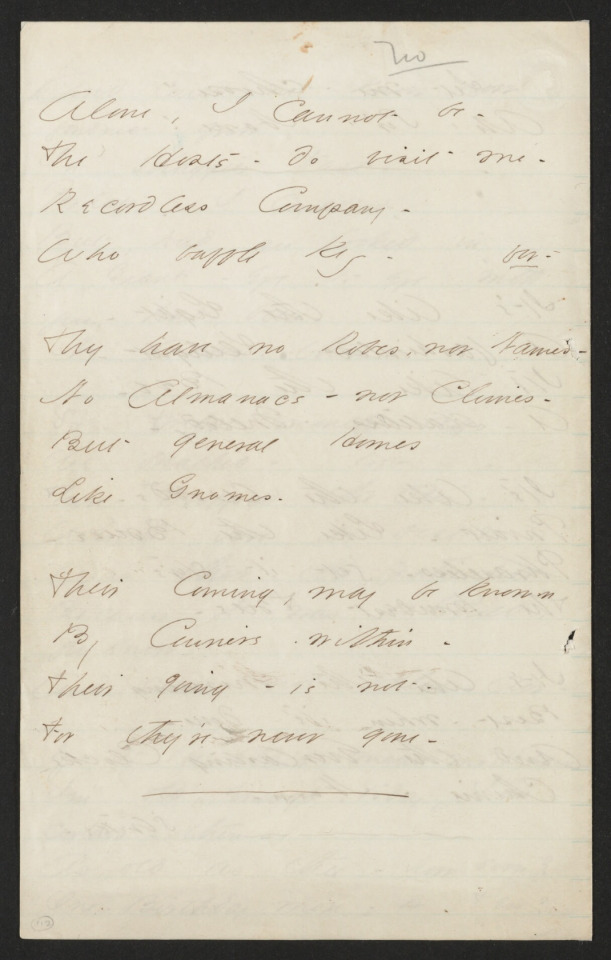
Emily Dickinson, Alone, I cannot be –, Poems: Packet XX, Fascicle 10. Includes 13 poems, written in ink, ca. 1861 [(112c). Emily Dickinson Archive. Houghton Library, Harvard University, Cambridge, MA. CC BY-NC-ND 3.0]
Bibl.: The Complete Poems of Emily Dickinson, Edited by Thomas H. Johnson, Little, Brown and Company, Boston, MA, and Toronto, 1960, p. 140
Alone, I cannot be – (J298, Fr303) Alone, I cannot be – for – The Hosts – do visit me – Recordless Company – Who baffle Key – They have no Robes, nor Names – No Almanacs – nor Climes – But general Homes Like Gnomes – Their Coming, may be known By Couriers within – Their going – is not – For they're never gone –
#manuscript#handwriting#calligraphy#poetry#book#emily dickinson#thomas h. johnson#little brown and company#houghton library#1860s#1960s
20 notes
·
View notes
Text

"Virginia Woolf seated in an armchair looking toward a window: black and white photograph, undated,” Virginia Woolf Monk’s House photographs, Houghton Library, Harvard University Library.
The Special Collections Research Center is pleased to announce a new exhibit featuring Virginia Woolf's most famous novel, Mrs. Dalloway. Enjoy this display in the Hatcher Gallery Exhibit Room from September 3 to December 13.
Read more!
#libraries#archives#special collections#special collections libraries#libraries and archives#special collections and archives#exhibits#exhibitions#mrs dalloway#virginia woolf
171 notes
·
View notes
Text
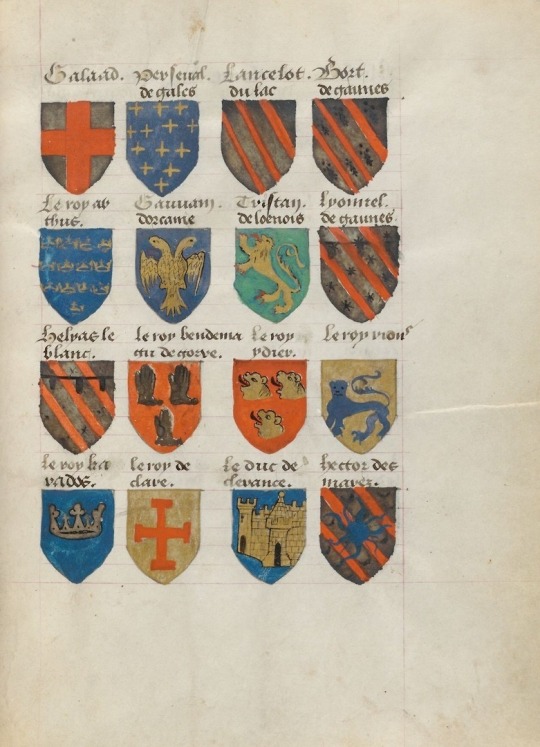
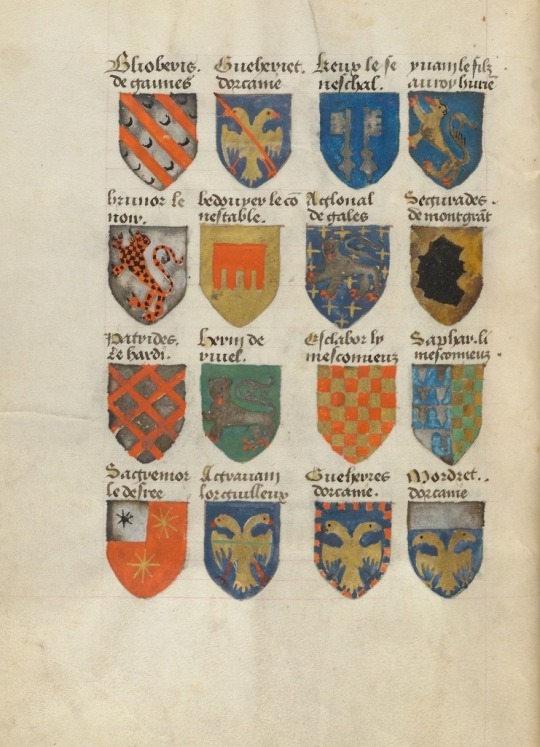
Arthurian coats of arms from "Works on knighthood and tournaments" collection. Houghton Library, Harvard University.
#heraldry#coat of arms#manuscript#illuminated#history#mythology#knights#knight#chivalry#chivalric#galahad#percival#lancelot#king arthur#gawain#tristan#europe#england#britain#medieval#middle ages#knighthood#knights of the round table#round table
943 notes
·
View notes
Note
Hi! Possibly a bit of a weird question for you, but I'm trying to collect all of YW in hardbacks before my old omnibus finally gives out, and I was wondering - do you know if books 1-4 ever got published in hardback with the Harcourt black base/white text cover art? So many websites use blank placeholders that I can't tell if what I'm searching for even exists!
It’s not weird at all. I get occasional inquiries (especially from librarians) about how to get their hands on complete hardcover sets of the Young Wizards books.
Let's make this simpler from the start by establishing that in the forty-plus year history of the series, there has never been a unified hardcover edition of all the YW books, from any of their publishers... mostly because there've been too many publishers over that stretch of time.
Let's take the books in order, as far as possible, and you'll see what happened.
The books' first home was at Delacorte Press, an imprint of Dell Publishing. So You Want To Be A Wizard was published in hardcover in 1983, the Deep Wizardry hc in 1985, and the High Wizardry hc in 1990, with these covers. (The art, respectively, by David Wiesner, Darrell Sweet, and Neal McPheeters.)

All of these editions are now difficult to find in good condition, especially SYWTBAW—which as a first book in a series by a new/untried author, perhaps understandably had a very small print run and was mostly sold to libraries. (The run might have been as small as 1500 copies. It's hard to tell now, as this wasn't data that was shared with authors in those days.) As a result, most copies of the Delacorte SYWTBAW hc are either very beat up, or (if signed and/or in good condition) relatively expensive. The Delacorte DW and HW hardcovers are a little easier to find, but not that much.
In the early 1990s there was a change in publishing direction at Dell shortly after HW came out. The publisher's interest had pivoted toward wanting more bestselling authors; so they jettisoned many then-new or midlist authors so as to be able to pay the best-selling authors more. (In this particular micro-bonfire of the vanities, Dell's stupidity in throwing Jane Yolen overboard, FFS, astounds me to this day.) So though the books continued to be published as paperbacks at other Dell imprints (Laurel-Leaf, Yearling) through the mid-1990s, that was the end of the Dell hardcovers.
The next hardcover publication was therefore in 1990, from GuildAmerica / SF Book Club. Support Your Local Wizard contains SYWTBAW, DW and HW, and was a Book Club bestseller: it sold a quarter million copies and set a record as their most popular new-member-requested book that lasted until they went out of business. As a result, there are a lot of these books around.
Also in plentiful supply is The Young Wizards, which SFBC Fantasy published in 2001. (NB that a lot of sources list this as being a 1984 book, which is incorrect. As it also contains, besides the first three, A Wizard Abroad and The Wizard's Dilemma, this makes it impossible to have been published any sooner than 2001.)

Anyway, after that, things get a bit simpler. In the mid 1990s the series was picked up by Houghton Mifflin Harcourt / Harcourt Trade Publishers' new YA imprint Magic Carpet Books, which began republishing earlier works. Possibly the oddest of these was a small-format (mmpb-sized) hc of SYWTBAW, which turns up here and there used. (I really need to ask Jane some time what the heck the thinking was on this book...)
...Anyway. A Wizard Abroad had until then been published only in the UK (in a mass-market mmpb from Transworld/Corgi); its first hardcover came out from the SF Book Club/GuildAmerica in 1993, Dell having passed on acquiring it. (The cover on this one was done by the fabulous David Cherry, artist and brother of my old colleague C. J. Cherryh.) Harcourt did another of the unusual small-format hardcovers, this time of AWAb, in 1997—testing the waters, I think. Then, when that sold strongly, they went straight to full-size hardcovers with The Wizard's Dilemma (with art from then until now being done by Cliff Nielsen) and have stayed with that format since.

Harcourt also did a lovely 25th anniversary hardcover edition of So You Want To Be A Wizard in 2003, which is easy to find inexpensively. I strongly suspect this republication trend would have continued with Deep Wizardry and High Wizardry when their respective anniversaries came around. But unfortunately the Magic Carpet program wound down soon afterwards, and the most recent hc volumes have been published simply as HMH, with no apparent interest at the publisher in going back to fill the holes in the hardcover backlist.
...So you can see, you've got kind of a mixed bag to deal with in terms of what you want. Availability has also been something of an issue, as the books are considered pretty deep backlist by Harcourt's current owner (HarperCollins), and warehouse supplies of some books in the series have been iffy.
So. The simplest I can make things for you is to help you avoid dealing with large corporate warehouses (because when some of these hc editions were preparing to go out of print, whenever possible I bought up the remaining stock to spare it from being pulped). Signed Books Direct—by which I mean the Ikea shelves out back in our boot room—has ample mint-condition supplies of many of the Harcourt hardcovers (though not Games Wizards Play, unfortunately: we've run out of those). Ignore the site’s front page inventory, which needs to be updated. Instead, just drop an email to the SBD email address and query me about what you're looking for.
HTH!
126 notes
·
View notes
Text

Leonardi de bello italico adversus gothos gesto : manuscript, [between 1450 and 1475]
MS Lat 170. Houghton Library, Harvard University.
79 notes
·
View notes